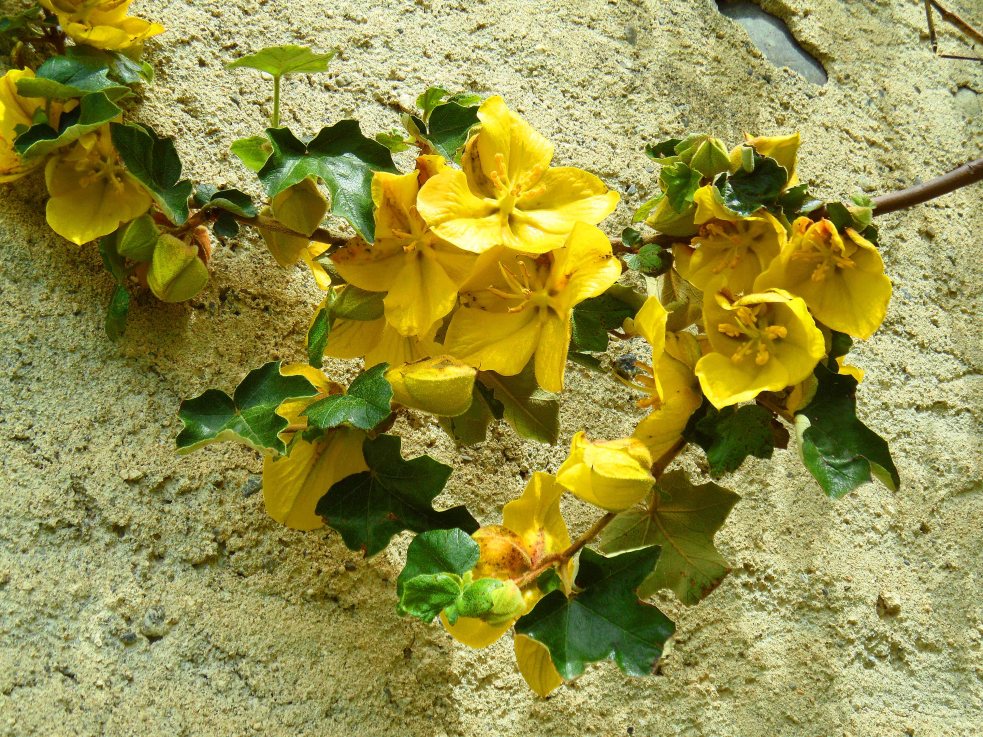Sometimes you need to go away and come back again, to see the garden in a different way. Having had a day away in the Valle d’Aran just over into Spain, coming back yesterday afternoon and evening was almost a re-discovery. It was partly thanks to the soft light of late evening, which gave a kindly glow to plants that are suffering, again, owing to drought since our last rain, but it was also that I realised I often look at the garden from the same vantage points, and so, I see the same things. If you couple this with my usual micro-vision tendencies, where I examine the individual performance of a particular plant- it’s a wonder I am not totally blind really.
So, this is what I noticed yesterday evening, as if for the first time.

The light really caught it. Begonia grandis subsp. evansiana ‘Claret Jug’ shines out from the image with the ruby-red leaf backing picking up the light. It is such an easy plant. Although often described as hardy, I wouldn’t risk it even in our often mild, wet winters. I grow it in a massive pot, partly filled with polystyrene chips to reduce the weight, and I just lug it into a covered, but open space in November, keep it pretty dry, and then start watering in March under cover. I drag it out in April and the rest is all done without my help, though I do a weekly feed from about May onwards. I am not really a begonia flower person, so the pink flowers are not my thing, but they are small and the leaves are the main act. Tons of tiny bulbils get scattered and so you will have this plant forever, and keep your friends supplied if you just pot them up in the autumn.

I have often raved about Verbena bonariensis. I love it for it’s attractiveness to butterflies and other insects, for it’s abundant self-seeding (which can also be a pain), but mostly for the electric quality of the flowers. In low light, it’s as if it’s wired to the mains.

This is a new view. I am looking back towards the back of the house, across the top of my only-planted-this-year-from-seed-grown-last-year area. This area has toiled a bit in it’s first year, finding the spring very cold, the summer very dry and the wind very debilitating. But, I think it will make it, although this year will be a bit of a damp squib. These Liatris spicata bulbs, bought from Aldi for 60 bulbs at E3, a total bargain, have done a great job in providing some points of punctuation where flowering, as I hoped, has not quite materialised. I don’t find Liatris a reliable returner year on year, I probably lose about 50% of them over a wet winter, but, they are so cheap and dependable, that I am still a great fan. In the US, where they are native plants, they are often called ‘Blazing Star’- you can see why, something of the electric about them too.

This is a new view as far as the further away view is concerned. In the foreground, is a reliable and terrific Pennisetum alopecuroides which I bought ages ago, put in the wrong place, replanted and now it adores where it is. Slightly flattened by dryness, it is a gentle punctuation point at the end of the promontory bed. It may be the variety, ‘Hameln’ but I can’t remember after all this time. ‘Hameln’ is supposed to be the hardiest of the varieties and so it may well be that. The thing with Pennisetum is that nothing seems to be happening in the growth department until really late in Spring, then up it pops, so it’s important not to poke it and panic. The other main new-this-year-area is encircling the olive tree, and I have planted, though you can’t see it, another Pennisetum, Pennisetum alopecuroides f. viridescens. I couldn’t resist the idea of dark-charcoal-purple-black flowerheads meeting, almost head-on in a Pennsietum-off, the older Pennisetum you see above in the photograph.

This is a new view to me. The foreground is of the new area encircling the olive, this year planted with, a great success in our dry summer, Cosmos bipinnatus ‘Xanthos’ has been sterling. It might even win me over to annuals. But the real feature of the view is the borrowed landscape. It is the dark green of the ornamental cherry tree, actually growing in a commune space, over our wall, which brings the Stipa gigantea to life. Without it as a backdrop, you would hardly see the delicate, golden flowerheads of the Stipa. Thank you, Tostat.

And this is a view that I nearly rejected. Then I thought, ‘hang on, it’s different’ and so it stays. Looking back across the grass towards the old privvy door, what you actually see is how comfortable the Hydrangea arboresecens ‘Annabelle’ is with its’ big, creamy flowers still looking good against the big leaves of Telekia speciosa. And further along to the left, you can imagine though not quite see, the now-pinky flowerheads of Hydrangea paniculata filling in the space.
So dry and thirsty, but not yet down and out. By contrast, the Valle d’Aran looked bewitchingly green.













